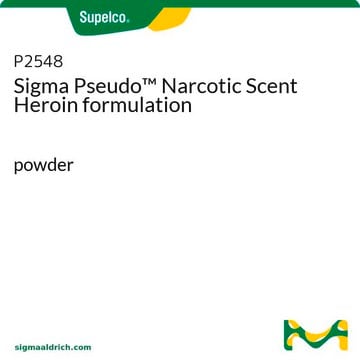P-007
PCP (Phencyclidine) solution
1.0 mg/mL in methanol, ampule of 1 mL, certified reference material, Cerilliant®
Synonym(s):
Phencyclidine
About This Item
Recommended Products
grade
certified reference material
form
liquid
feature
Snap-N-Spike®/Snap-N-Shoot®
packaging
ampule of 1 mL
manufacturer/tradename
Cerilliant®
drug control
Narcotic Licence Schedule A (Switzerland); psicótropo (Spain); Decreto Lei 15/93: Tabela IIA (Portugal)
concentration
1.0 mg/mL in methanol
technique(s)
gas chromatography (GC): suitable
liquid chromatography (LC): suitable
application(s)
forensics and toxicology
format
single component solution
storage temp.
2-8°C
InChI
1S/C17H25N/c1-4-10-16(11-5-1)17(12-6-2-7-13-17)18-14-8-3-9-15-18/h1,4-5,10-11H,2-3,6-9,12-15H2
InChI key
JTJMJGYZQZDUJJ-UHFFFAOYSA-N
General description
Application
- A Collaborative Platform for Novel Compound Identification - Characterization of Designer Phencyclidines (PCPs) POXP, PTHP, and P2AP: This research highlights a collaborative platform for the identification and characterization of novel designer PCPs, emphasizing their potential as analytical standards and sigma receptor agonists. The study provides valuable insights for scientists involved in receptor binding studies and the development of dissociative anesthetics for research (Sisco, Urbas, 2023).
- Long-term adaptation of prefrontal circuits in a mouse model of NMDAR hypofunction: Investigating the long-term effects of NMDAR hypofunction in mice, this study uses PCP to elucidate mechanisms of schizophrenia, showcasing its application as a NMDA receptor antagonist in neuropharmacological studies. The findings are crucial for advancing knowledge on neurotransmitter research and mental health disorders (Ponserre et al., 2024).
- 3-Methoxy-Phencyclidine Induced Psychotic Disorder: A Literature Review and an (18)F-FDG PET/CT Case Report: This review and case report discuss the psychiatric implications of 3-Methoxy-Phencyclidine, a derivative of PCP, providing insights into its effects on human cognition and behavior. Such studies are essential for developing high-purity PCP liquids for sigma receptor assays and understanding its role as a non-competitive NMDA antagonist (Pepe et al., 2024).
- Trips Through the Skin: Reviewing Cutaneous Drug Reactions to Psychedelics and Hallucinogens: This review explores the dermatological reactions associated with psychedelic drugs, including PCP. It underscores the importance of understanding the biochemical pathways affected by PCP, reinforcing its utility as a research chemical in pharmaceutical applications (Rahman et al., 2024).
- Novel α-amino-3-hydroxy-5-methyl-4-isoxazole-propionic acid receptor (AMPAR) potentiator LT-102: A promising therapeutic agent for treating cognitive impairment associated with schizophrenia: This research explores the potential therapeutic uses of AMPAR potentiators, highlighting PCP′s role in enhancing understanding of glutamatergic dysfunction in schizophrenia. It showcases PCP′s utility in developing treatments that modulate neurotransmitter systems, valuable for neuropharmacology research (Qi et al., 2024).
Legal Information
Signal Word
Danger
Hazard Statements
Precautionary Statements
Hazard Classifications
Acute Tox. 3 Dermal - Acute Tox. 3 Inhalation - Acute Tox. 3 Oral - Flam. Liq. 2 - STOT SE 1
Target Organs
Eyes,Central nervous system
Storage Class Code
3 - Flammable liquids
WGK
WGK 2
Flash Point(F)
49.5 °F - closed cup
Flash Point(C)
9.7 °C - closed cup
Certificates of Analysis (COA)
Search for Certificates of Analysis (COA) by entering the products Lot/Batch Number. Lot and Batch Numbers can be found on a product’s label following the words ‘Lot’ or ‘Batch’.
Already Own This Product?
Find documentation for the products that you have recently purchased in the Document Library.
Customers Also Viewed
Our team of scientists has experience in all areas of research including Life Science, Material Science, Chemical Synthesis, Chromatography, Analytical and many others.
Contact Technical Service















